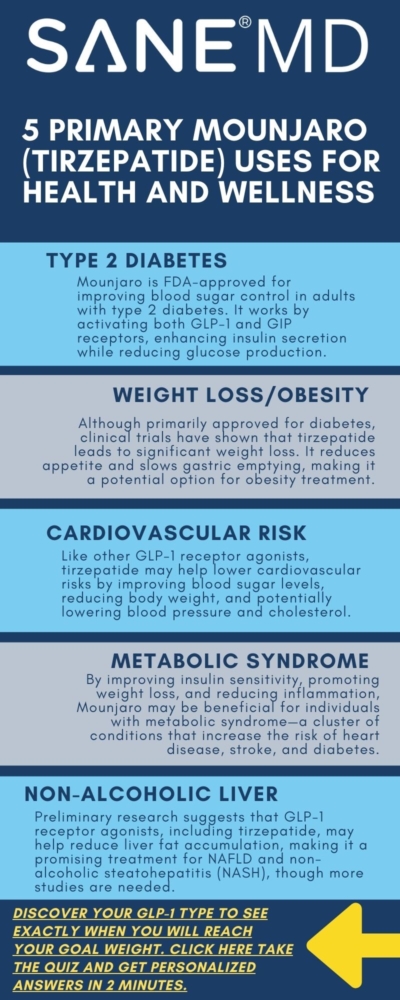Mounjaro (Tirzepatide) Uses: Diabetes, Weight Loss, & More

Mounjaro (tirzepatide) is an injectable medication approved by the Food and Drug Administration (FDA) for type 2 diabetes management. Mounjaro (tirzepatide) is classified within the drug class of glucose-dependent insulinotropic polypeptide (GIP) and glucagon-like peptide-1 (GLP-1) receptor agonists. By targeting these pathways, Mounjaro improves blood sugar control and has shown promising weight loss effects in clinical trials.
This article explores Mounjaro (Tirzepatide) uses, its effects on weight loss, diabetes, and other health conditions, alongside potential side effects and precautions.
Key Takeaways
- Mounjaro (tirzepatide) is FDA-approved for type 2 diabetes treatment and is being explored for weight loss and other potential uses.
- It helps lower blood sugar levels by mimicking natural gut hormones that regulate insulin and appetite.
- Mounjaro treatment can aid in weight loss when combined with a reduced-calorie diet and exercise, though it comes with potential side effects.
Mounjaro (Tirzepatide) and Diabetes Management
Managing type 2 diabetes requires a combination of lifestyle changes, medications, and close monitoring of blood sugar levels. While many diabetes medications help regulate blood sugar, Mounjaro (tirzepatide) stands out due to its dual-action mechanism that mimics natural gut hormones to enhance insulin production and appetite control.
Approved by the Food and Drug Administration (FDA), Mounjaro is prescribed to improve blood sugar control in adults with type 2 diabetes mellitus, often in conjunction with other diabetes medications.
This section explores how Mounjaro works to regulate blood sugar, its role in combination therapy, and its potential impact on diabetic complications like retinopathy.
How Mounjaro Helps Diabetes Patients
Mounjaro prescription is primarily intended for individuals with type 2 diabetes mellitus. It functions by mimicking two key gut hormones involved in blood sugar regulation:
- Glucose-dependent insulinotropic polypeptide (GIP) – Stimulates insulin release from the pancreas in response to food intake while simultaneously reducing glucagon secretion, which prevents excessive blood sugar spikes.
- Glucagon-like peptide-1 (GLP-1) – Enhances insulin production, slows digestion, and suppresses appetite, leading to better post-meal blood sugar control.
By targeting both of these pathways, Mounjaro treatment helps lower blood sugar levels while also supporting weight management, an important factor for many individuals with type 2 diabetes.
Additionally, its ability to slow gastric emptying reduces post-meal glucose spikes, providing a more stable blood sugar profile throughout the day.
Blood Sugar Control and Diabetes Medications
Maintaining healthy blood sugar levels is essential for preventing diabetes-related complications. Despite lifestyle changes, many patients struggle to regulate their blood sugar effectively with standard treatments. Mounjaro is often prescribed alongside other diabetes medications, such as:
- Metformin – A first-line medication that lowers glucose production in the liver and improves insulin sensitivity.
- Insulin glargine – A long-acting insulin that helps maintain steady blood sugar levels between meals.
Combining Mounjaro with other diabetes medications enhances overall blood sugar control, reducing the risk of hyperglycemia and other complications.
However, because Mounjaro influences insulin secretion, patients should monitor their blood sugar levels closely to prevent low blood sugar (hypoglycemia), especially when using insulin or sulfonylureas.
Mounjaro and Diabetic Retinopathy
Diabetic retinopathy is a serious complication of prolonged high blood sugar levels, leading to vision problems and, in severe cases, blindness. Research suggests that maintaining an average blood sugar level can slow the progression of this condition. Since Mounjaro treatment improves blood sugar control, it may help reduce the risk of diabetic retinopathy in some patients.
However, rapid improvements in blood sugar control, particularly in patients with long-standing diabetes, have been associated with a temporary worsening of diabetic retinopathy. Individuals with pre-existing eye conditions should consult their doctor or pharmacist before starting Mounjaro to assess potential risks and determine the best course of action.
By effectively managing blood sugar levels, Mounjaro can play a key role in diabetes treatment. However, like all medications, it should be used under the supervision of a healthcare professional to minimize risks and maximize benefits.
Mounjaro for Weight Loss
If you are wondering, does Mounjaro help with weight loss? The answer appears to be “yes.” While Mounjaro (tirzepatide) is primarily approved for managing type 2 diabetes, it has also gained widespread attention as a promising weight loss drug. Many individuals with diabetes struggle with excess weight, which can exacerbate insulin resistance and increase the risk of other health complications.
However, research suggests that Mounjaro’s mechanism of action—targeting both glucose-dependent insulinotropic polypeptide (GIP) and glucagon-like peptide-1 (GLP-1) receptors—may offer significant weight loss benefits even for those without diabetes.
By slowing digestion, promoting satiety, and reducing appetite, Mounjaro helps compatible individuals achieve sustainable weight loss when combined with a reduced-calorie diet and exercise.
This section explores how Mounjaro promotes weight loss, its effectiveness in clinical trials, and how it compares to other weight loss drugs.

How Mounjaro Promotes Weight Loss
Mounjaro for weight loss is gaining popularity due to its dual-action effect on metabolism and appetite regulation.
Unlike traditional weight loss medications that primarily suppress appetite, Mounjaro works through multiple pathways to facilitate weight reduction:
- Delays gastric emptying: Mounjaro slows down the digestion process, making individuals feel full for longer and reducing overall calorie intake.
- Reduces appetite: By mimicking natural gut hormones, Mounjaro decreases hunger signals, leading to fewer cravings and reduced food consumption.
- Enhances insulin sensitivity: Improved insulin function helps the body process glucose more efficiently, preventing fat storage and supporting weight management.
These combined effects make Mounjaro a valuable tool for body weight reduction in certain individuals struggling with obesity or weight-related metabolic disorders.
Clinical Trials on Mounjaro as a Weight Loss Drug
Recent clinical trials have evaluated the effectiveness of Mounjaro treatment in individuals with and without diabetes.
Research suggests that patients using Mounjaro, alongside a reduced-calorie diet and exercise, experience significant weight loss compared to those on placebo or other diabetes medications.
Key findings from clinical trials include:
- Patients on the highest dose of Mounjaro lost up to 22.5% of their body weight, which is greater than results seen with other weight loss drugs.
- Mounjaro outperformed other diabetes medications, such as semaglutide (Ozempic, Wegovy), in terms of weight reduction.
- Weight loss was sustained over time, indicating Mounjaro’s potential for long-term weight management.
Given these promising results, researchers are exploring Mounjaro’s potential FDA approval as a dedicated weight loss drug for individuals without diabetes.
Comparing Mounjaro to Other Weight Loss Medications
Mounjaro has demonstrated greater efficacy in weight loss compared to GLP-1 receptor agonists (e.g., Wegovy, Saxenda) and older appetite suppressants in clinical studies.
Here’s how Mounjaro stacks up:
| Medication | Mechanism | Average Weight Loss (%) | Additional Benefits |
|---|---|---|---|
| Mounjaro (Tirzepatide) | GLP-1 & GIP receptor agonist | Up to 22.5% | Blood sugar control, appetite suppression |
| Wegovy (Semaglutide) | GLP-1 receptor agonist | ~15% | Appetite suppression, improved metabolic markers |
| Saxenda (Liraglutide) | GLP-1 receptor agonist | ~8-10% | Appetite suppression, blood sugar regulation |
| Phentermine-Topiramate (Qsymia) | Appetite suppressant | ~5-10% | Energy boost, appetite suppression |
| Orlistat (Alli, Xenical) | Fat absorption inhibitor | ~5-7% | Reduces fat absorption |
While Mounjaro for weight loss shows great promise, its long-term effects on weight management and metabolic health still require further study.
Additionally, it is essential for individuals considering Mounjaro to consult a doctor or pharmacist to assess whether it is the right option based on their medical conditions and weight loss goals.
As research continues, Mounjaro has the potential to become a widely used weight management therapy, particularly for individuals with obesity-related health conditions.
Dosage, Administration, and Missed Dose Guidelines
How to Take Mounjaro
Mounjaro is available in the following dosage forms:
- Single-dose injection pens for subcutaneous use
- Recommended to be injected into the upper arm, abdomen, or thigh. See our comprehensive guide on the best and safest Mounjaro injection sites.
Handling a Missed Dose
If a dose is missed, it should be taken as soon as possible, unless the next dose is due within two days. Taking too much Mounjaro can cause severe nausea and low blood sugar.
Storage Guidelines
Proper storage is crucial to maintaining Mounjaro’s effectiveness. It should be stored in a refrigerator, but it can also be kept at room temperature for up to 21 days.
Potential Side Effects and Risks
But is Mounjaro safe? Like all medications, this GLP-1 drug comes with certain risks. Mounjaro comes with risks and side effects, including the following:
Common Side Effects of Mounjaro
Mounjaro side effects may include:
- Nausea
- Vomiting
- Diarrhea
- Decreased appetite
- Injection site reactions
Severe Side Effects
Some patients may experience severe allergic reactions, such as:
- More severe allergic reactions involving swelling, difficulty breathing, and rash
- Inflammation of the pancreas, which presents as severe abdominal pain
- Kidney problems, particularly in those with pre-existing kidney disease
- Increased risk of thyroid cancer or thyroid C-cell tumors
Thyroid Cancer and Tumor Risks
Mounjaro carries a boxed warning regarding the potential risk of thyroid tumors, including thyroid cancer. Individuals with a personal or family history of medullary thyroid cancer should avoid this medication.
Drug Interactions and Precautions
Drug Interactions
Mounjaro drug interactions can also occur. These include:
- Other diabetes medications (e.g., insulin, metformin)
- Over-the-counter medications
- Drug combination therapies
Effects on Birth Control Pills
Mounjaro may reduce the effectiveness of birth control pills. Alternative contraception methods should be considered.
Drinking Alcohol and Mounjaro Use
Drinking alcohol while on Mounjaro can increase the risk of low blood sugar. It is advisable to monitor blood sugar levels closely if consuming alcohol.
Who Should Not Take Mounjaro?
Contraindications
Mounjaro is not recommended for:
- Individuals with a history of severe allergic reactions to tirzepatide
- Those with a personal or family history of thyroid C-cell tumors
- Patients with severe kidney disease or diabetic retinopathy
Special Populations
- Pregnant and breastfeeding women: Mounjaro’s effects on breast milk are unclear, and pregnant women should consult their healthcare professional before use.
- Individuals with inflammation of the pancreas: Mounjaro may worsen this condition.
The Future of Mounjaro
Mounjaro (tirzepatide) has already made a significant impact in the treatment of type 2 diabetes and weight loss, but its potential extends beyond these primary indications. With ongoing research, this medication could soon be recognized for a broader range of metabolic and cardiovascular health benefits.
Scientists and medical professionals are closely monitoring Mounjaro treatment as it undergoes additional clinical trials, and regulatory agencies like the Food and Drug Administration (FDA) continue to evaluate its safety, effectiveness, and potential new approvals.
This section explores how Mounjaro’s uses may expand in the future, the critical role of healthcare professionals, and what to expect in terms of regulatory developments.
Expanding Uses Beyond Diabetes and Weight Loss
Although Mounjaro is currently approved for type 2 diabetes, researchers are actively investigating its effects on other metabolic and cardiovascular conditions. Studies suggest that its unique mechanism of action—targeting both glucose-dependent insulinotropic polypeptide (GIP) and glucagon-like peptide-1 (GLP-1) receptors—could provide additional health benefits, including:
- Cardiovascular Health Improvements – Mounjaro may help reduce the risk of heart disease by lowering blood pressure, improving lipid profiles, and reducing body weight—all key factors in preventing cardiovascular events like heart attacks and strokes.
- Fatty Liver Disease (Non-Alcoholic Steatohepatitis, NASH) – Preliminary research suggests that Mounjaro may improve liver function in individuals with NASH by promoting weight loss and enhancing insulin sensitivity.
- Polycystic Ovary Syndrome (PCOS) – Given its impact on insulin resistance and weight management, Mounjaro is being studied as a potential treatment for PCOS, which affects hormone regulation and reproductive health.
- Alzheimer’s and Neurodegenerative Diseases – Some studies suggest that glucose-dependent insulinotropic polypeptide (GIP) may have neuroprotective effects, making Mounjaro a candidate for research into cognitive health and dementia prevention.
As clinical trials continue, we may see Mounjaro prescription expand into new therapeutic areas, offering hope for individuals struggling with various metabolic and inflammatory conditions.
The Role of Healthcare Professionals
Before starting Mounjaro treatment, consulting a doctor or pharmacist is essential, particularly for individuals taking other medications or managing multiple medical conditions.
Healthcare providers play a crucial role in:
- Assessing suitability – A healthcare professional can determine whether Mounjaro is appropriate based on a patient’s medical conditions, including a personal or family history of thyroid tumors, kidney disease, or diabetic retinopathy.
- Monitoring potential side effects – Mounjaro is associated with side effects such as low blood sugar, severe nausea, and abdominal pain, which should be managed under medical supervision.
- Addressing drug interactions – Mounjaro may interact with other diabetes medications, birth control pills, and over-the-counter drugs, potentially affecting their efficacy.
- Providing dosing guidance – To minimize risks associated with a missed dose or taking too much Mounjaro, patients should follow a regular dosing schedule as prescribed by their healthcare provider.
As Mounjaro continues to evolve in clinical practice, healthcare professionals will be instrumental in guiding patients through its safe and effective use.
Regulatory Approvals and Drug Administration FDA Updates
The Food and Drug Administration (FDA) has already approved Mounjaro for type 2 diabetes treatment, and ongoing studies may lead to further approvals in other areas.
Regulatory bodies are closely monitoring its safety, side effects, and long-term effectiveness, particularly in the context of:
- Mounjaro for weight loss – Given its impressive weight reduction results in clinical trials, Mounjaro is expected to receive FDA approval as a dedicated weight loss drug in the near future.
- New dosage forms – Researchers are investigating alternative delivery methods beyond injection site administration, including oral formulations.
- Long-term cardiovascular outcomes – As with other diabetes medications, regulatory agencies are assessing whether Mounjaro reduces the risk of heart disease and stroke.
Future FDA decisions regarding drug administration will depend on emerging data from clinical trials. If approved for broader weight management and metabolic health indications, Mounjaro has the potential to be a widely used treatment for obesity and related conditions.
Frequently Asked Questions (FAQ) About Mounjaro (Tirzepatide)
Mounjaro (tirzepatide) is an injectable medication primarily approved for treating type 2 diabetes, but it is also gaining recognition for its potential as a weight loss drug. Given its growing popularity, many people have questions about how it works, who can take it, and what to expect in terms of results.
Below, we answer some of the most frequently asked questions about Mounjaro and tirzepatide to provide a clearer understanding of its effects and uses.
1. What does tirzepatide do to your body?
Tirzepatide is a dual glucose-dependent insulinotropic polypeptide (GIP) and glucagon-like peptide-1 (GLP-1) receptor agonist that regulates blood sugar, enhances insulin secretion, and suppresses appetite. It helps control blood sugar levels by mimicking natural gut hormones, stimulating insulin production when needed, and reducing glucagon release to prevent high blood sugar.
Additionally, it slows digestion, leading to increased feelings of fullness and decreased appetite, making it effective for both diabetes management and weight loss.
2. What does Mounjaro do to your body?
Mounjaro affects the body by:
- Lowering blood sugar levels in individuals with type 2 diabetes.
- Suppressing appetite by slowing gastric emptying.
- Aiding in weight loss by reducing food intake and increasing energy expenditure.
- Improving insulin sensitivity, helping the body use glucose more efficiently.
By acting on both GIP and GLP-1 receptors, Mounjaro has a more substantial effect on metabolism compared to traditional diabetes medications, making it a promising treatment for both diabetes and weight loss.
3. What is tirzepatide (Mounjaro) used for?
Tirzepatide, marketed under the brand name Mounjaro, is FDA-approved for the treatment of type 2 diabetes to improve blood sugar control.
However, due to its significant weight loss effects, it is being studied and considered for FDA approval as a weight loss drug.
Currently, Mounjaro is prescribed for:
- Managing type 2 diabetes mellitus
- Lowering blood sugar levels
- Potential weight management in overweight or obese individuals (off-label use)
Future research may expand its use to cardiovascular health, fatty liver disease, and other metabolic conditions.
4. Can you take Mounjaro if you are not diabetic?
Mounjaro is sometimes prescribed off-label for weight loss in compatible individuals who do not have diabetes. Clinical trials have shown that people without diabetes can lose significant weight on Mounjaro when combined with a reduced-calorie diet and exercise.
However, because it is currently only FDA-approved for type 2 diabetes, individuals without diabetes should consult a doctor or pharmacist before considering Mounjaro for weight loss.
If approved by the Food and Drug Administration (FDA) for weight management, it may become widely available for non-diabetic patients seeking to lose weight.
5. Is tirzepatide the same as Mounjaro?
Tirzepatide is the active ingredient in Mounjaro. Mounjaro is the brand name under which tirzepatide is marketed.
While Mounjaro contains tirzepatide, other brand names and formulations of tirzepatide, such as Zepbound, are also available for weight loss and may expand further with additional FDA approvals.
6. Who cannot take tirzepatide?
Mounjaro (tirzepatide) is not suitable for everyone.
Individuals who should not take tirzepatide include:
- People with a personal or family history of thyroid cancer, particularly medullary thyroid carcinoma (MTC) or multiple endocrine neoplasia syndrome type 2 (MEN2).
- Individuals with a history of severe allergic reactions to tirzepatide or any of its components.
- Patients with a history of pancreatitis, as tirzepatide may increase the risk of inflammation of the pancreas.
- People with severe kidney disease or those on dialysis.
- Pregnant or breastfeeding women, as the effects of tirzepatide on breast milk and fetal development are not well studied.
It is crucial to consult a healthcare professional before starting Mounjaro to ensure it is safe based on your medical history and any other medications you are taking.
7. How much weight can you lose on tirzepatide?
Clinical trials have shown that individuals using Mounjaro for weight loss can lose up to 22.5% of their body weight, depending on the dosage and duration of treatment.
The average weight loss results are:
- 5 mg dose: ~15% of body weight over 72 weeks
- 10 mg dose: ~20% of body weight over 72 weeks
- 15 mg dose: ~22.5% of body weight over 72 weeks
These results are significantly higher than those seen with other weight loss drugs like Wegovy (semaglutide) and Saxenda (liraglutide).
However, individual results may vary, and diet and exercise play a crucial role in maximizing weight loss on Mounjaro.
8. How quickly do you lose weight on Mounjaro?
Weight loss on Mounjaro varies from person to person, but most people begin to see results within the first few weeks of treatment.
Clinical data suggests:
- Noticeable weight loss begins within 4-6 weeks.
- Significant reductions in body weight occur by 3-6 months.
- Peak weight loss results are typically seen after 12-18 months.
Factors that influence weight loss speed include:
- Dosage – Higher doses (e.g., 10 mg or 15 mg) tend to produce faster weight loss.
- Diet and exercise – Combining Mounjaro with a reduced-calorie diet and regular physical activity enhances results.
- Starting weight – Individuals with higher body weight often experience more dramatic early weight loss.
For best results, consistent use and lifestyle modifications are recommended.
Conclusion
Mounjaro (tirzepatide) is an FDA-approved medication for diabetes management that has also demonstrated significant weight loss effects in clinical studies. Its ability to improve blood sugar control and aid in weight management makes it a promising treatment option.
However, it comes with potential risks, including severe side effects, allergic reactions, and thyroid cancer concerns. Consulting a healthcare professional before starting Mounjaro treatment is essential to ensure safety and efficacy.

Mounjaro Injection Sites: Where & How to Inject Safely

Mounjaro is a prescription medication developed by Eli Lilly for managing type 2 diabetes. Learn more about Mounjaro (tirzepatide) uses, including its role in diabetes management and weight loss, in our detailed guide.
It is administered via subcutaneous injection, which means it is injected into the fatty tissue just beneath the skin.
Compatible patients also use Mounjaro off-label for weight loss, as clinical trials have shown promising results in this area.
Understanding the best Mounjaro injection sites is crucial to ensure proper absorption, minimize discomfort, and reduce the risk of injection site reactions.
If you’re wondering if Mounjaro is safe to inject, this guide explains the best places to inject this drug, techniques for minimizing discomfort, and how to safely rotate your injection sites to maintain effectiveness.
Key Takeaways
- Mounjaro injection sites include the thigh, abdomen, and upper arm.
- The best place to inject Mounjaro varies based on personal preference and treatment plan.
- Rotating injection sites help prevent injection site reactions and skin irritation.
- Proper preparation, including using an alcohol swab and removing the outer needle shield, ensures a safe and comfortable injection.
- Mounjaro injections should always be disposed of in a sharps container.
Mounjaro Injection Sites: Comparison Chart
| Injection Site | Advantages | Considerations | Best Practices |
|---|---|---|---|
| Abdomen | Large surface area, easy accessibility, relatively low sensitivity to pain. | Avoid injecting near the belly button, scars, or bruising to minimize irritation. | Choose a spot at least two inches away from the belly button to avoid concentrated blood vessels and nerves. Rotate injection sites within the abdomen. |
| Thigh | Easily accessible, allows better control for self-administration. | May cause slightly more discomfort compared to the abdomen; avoid inner thigh due to increased blood vessels and nerves. | Inject in the front or outer thigh, about four inches above the knee and four inches below the hip. Apply an ice pack beforehand if discomfort occurs. |
| Upper Arm | Alternative option, commonly used by healthcare professionals. | Difficult to reach without assistance; smaller fatty tissue area increases the risk of injecting into muscle. | Inject in the back of the arm where fatty tissue is most present. Use a steady grip on the dose knob to ensure full medication delivery. |
Where to Inject Mounjaro
Choosing the right Mounjaro injection site is essential for ensuring proper medication absorption, minimizing discomfort, and reducing the risk of injection site reactions, aka, one of the most common Mounjaro side effects.
The most commonly used injection sites include the abdomen, thigh, and upper arm. Each area offers different benefits depending on personal preference and ease of access.
1. Abdomen (Stomach Area)
The abdomen is one of the most preferred Mounjaro injection sites due to its large surface area, easy accessibility, and relatively low sensitivity to pain.
The fatty tissue in this area allows for effective subcutaneous injection, ensuring that the medication is correctly absorbed into the body.
- To inject Mounjaro correctly, choose a spot at least two inches away from the belly button to avoid sensitive areas where blood vessels and nerves are more concentrated.
- Avoid injecting Mounjaro near scars, stretch marks, or areas with bruising to minimize irritation.
- Some patients find that injecting Mounjaro in the abdomen results in a quicker onset of action, though scientific data on this remains inconclusive.
- Rotating injection sites within the stomach area helps prevent injection site reactions such as redness, swelling, or discomfort.
2. Thigh
The thigh is another effective injection site, particularly for those who prefer an easily accessible location.
It is a great choice for subcutaneous use as it provides a large surface area and allows for better control when self-administering the Mounjaro injection.
- The recommended place to inject Mounjaro in the thigh is the front or outer part, about four inches above the knee and four inches below the hip.
- Avoid injecting into the inner thigh, as this area contains more blood vessels and nerves, which could lead to increased discomfort.
- Some patients experience slightly more pain in the thigh compared to the abdomen, but this varies based on factors influencing pain sensation, such as needle depth and individual sensitivity.
- If you experience discomfort, try applying an ice pack to numb the area before injecting Mounjaro.
3. Upper Arm
The upper arm is another alternative injection site, though it may be more challenging to reach without assistance.
This area is commonly used by healthcare professionals when administering Mounjaro injections in a clinical setting.
- The best place to inject Mounjaro in the upper arm is the back of the arm, where fatty tissue is most present.
- Since the upper arm has a smaller area of fatty tissue compared to the thigh or abdomen, proper placement of the needle is essential to avoid injecting into muscle.
- Many patients find it challenging to inject Mounjaro in the upper arm without help, making this site less common for self-administration.
- If you choose the upper arm as your injection site, ensure that you maintain a steady grip on the dose knob to deliver the full Mounjaro dose correctly.
Rotating Injection Sites
To prevent injection site reactions, it is important to rotate injection sites regularly. Avoid injecting into the same spot repeatedly, as this can cause skin irritation, lumps, or poor medication absorption. Instead, alternate between the abdomen, thigh, and upper arm to give each injection site time to heal.
By understanding the benefits and considerations of each injection site, you can choose the best place to inject based on your treatment plan and personal preference.
If you have any concerns about injecting Mounjaro correctly, consult your healthcare provider for further guidance.
How to Inject Mounjaro Safely
1. Prepare the Injection
- Wash hands thoroughly.
- Select an injection site and clean the skin with an alcohol swab.
- Remove the outer needle shield from the new needle.
2. Administer the Injection
- Hold the pen at a 90-degree angle to the skin.
- Press the injection button and slowly count to ensure full dose delivery.
- Remove the pen and apply a cotton ball to the area if necessary.
3. Dispose of the Needle
- Always place used needles in a sharps container.
- Never reuse a needle to avoid infection.
Best Injection Site for Weight Loss
Currently, no clinical trials confirm the best injection site for weight loss.
However, certain patients report improved weight loss results when injecting Mounjaro into the abdomen.
This could be due to increased absorption rates in the fatty tissue of the stomach area.

Common Issues and How to Prevent Them
When injecting Mounjaro, some patients may experience mild side effects or discomfort at the injection site.
Proper technique, rotating injection sites, and avoiding sensitive areas can help minimize these issues.
Below are common concerns and best practices for preventing them.
1. Injection Site Reactions
Some patients may experience injection site reactions, including redness, swelling, bruising, or mild pain after administering Mounjaro injections.
These reactions are generally temporary and subside within a few hours to a few days.
To minimize irritation:
- Rotate injection sites with each dose to prevent excessive irritation or buildup of scar tissue.
- Avoid injecting Mounjaro into the same spot repeatedly, as this can lead to skin hardening or lumps.
- Applying a cotton ball with light pressure to the area after injection can help reduce mild bleeding or swelling.
- If discomfort persists, using a cold compress or ice pack for a few minutes post-injection can help soothe the skin.
2. Does Mounjaro Injection Hurt?
Pain levels vary from person to person, depending on factors such as needle size, injection technique, and skin sensitivity.
Some patients report minimal discomfort, while others may feel a slight stinging sensation.
To reduce pain during the Mounjaro injection:
- Use an ice pack to numb the injection site for a few minutes before administering the dose.
- Ensure you are using a new needle each time, as dull needles can cause more discomfort.
- Slowly count to maintain a steady hand while pressing the injection button to ensure a smooth and controlled delivery.
- If you experience severe pain, consult a healthcare provider to check your technique and ensure the medication is being injected correctly.
3. Avoid Injecting in Certain Areas
To prevent irritation, poor medication absorption, or unnecessary pain, avoid injecting Mounjaro in the following areas:
- Scar tissue: May cause uneven absorption of the medication.
- Moles or tattoos: These areas may have less fatty tissue, which can affect how the medication is processed.
- Open wounds or bruises: Injecting into damaged skin may cause additional irritation and slow healing.
- Bony areas or veins: Avoid injecting too close to bones or large blood vessels, as this may increase discomfort.
By following these guidelines, you can ensure a more comfortable experience when injecting Mounjaro and reduce the likelihood of side effects.
If you have ongoing discomfort or difficulty with injections, speak with a healthcare professional for further guidance.
Tips for Safe and Effective Injections
- Always check the dose window to confirm the correct Mounjaro dose.
- Ensure the active ingredient is slightly yellow, indicating proper medication quality.
- Remove air bubbles by tapping the pen before use.
- If you feel sick, consult your healthcare provider.
Frequently Asked Questions (FAQs) About Mounjaro Injection Sites
When using Mounjaro, selecting the right injection site and following best practices ensures effective medication absorption and minimizes discomfort.
Below are common questions and detailed answers to help you inject Mounjaro safely and effectively.
1. Where is the best place to inject Mounjaro?
The best Mounjaro injection sites are the abdomen, thigh, and upper arm. Many patients prefer the abdomen because it provides a large surface area and may allow for better absorption. However, some find the thigh easier to reach and less sensitive.
The upper arm can also be used, but it may require assistance.
The best place to inject Mounjaro depends on personal preference and comfort.
2. What happens if you inject Mounjaro in the wrong place?
If you inject Mounjaro into muscle instead of fatty tissue, it may not absorb properly, potentially reducing its effectiveness.
Injection site reactions, including pain, bruising, or swelling, are more likely if injected in an inappropriate area.
Avoid areas with scars, tattoos, or moles, as they may interfere with absorption. If you accidentally inject in the wrong place and experience persistent discomfort, consult a healthcare provider.
3. Is Mounjaro effective in the thigh?
Mounjaro injections are effective when administered in the thigh. The thigh is a recommended injection site as it contains fatty tissue, which allows for proper medication absorption.
Some users report slightly more discomfort when injecting in the thigh compared to the abdomen, but this varies from person to person.
To ensure effectiveness, inject Mounjaro at least a few inches away from the knee and hip and avoid injecting into muscle.
4. Should I pinch my skin when injecting Mounjaro?
Pinching the skin before injecting can help ensure that the needle reaches the fatty tissue rather than muscle. This is particularly useful for people with lower body fat.
Hold the skin firmly between two fingers and insert the needle at a 90-degree angle for the best results. Once the Mounjaro injection is complete, release the skin and remove the needle slowly to minimize discomfort.
5. Is it better to inject Mounjaro in the thigh or stomach?
Both the thigh and stomach are effective Mounjaro injection sites, but the abdomen is often preferred.
Some studies suggest that injections in the stomach area may result in faster absorption, though no clinical trials confirm this as the best injection site for everyone.
Injecting Mounjaro in the thigh can be easier for those who self-administer but may cause slightly more discomfort.
Rotating between the thigh and abdomen can help prevent irritation and improve long-term tolerability.
Conclusion
Using the proper Mounjaro injection sites and following best practices can enhance the effectiveness of the medication while reducing discomfort.
If you have concerns about injecting Mounjaro correctly, consult a healthcare professional to ensure you’re following the safest method.

What is Mounjaro? A Complete Guide for Beginners

Clinical trials have indicated that Mounjaro may lead to more significant weight loss compared to some other diabetes medications and weight loss drugs, including semaglutide-based treatments like Wegovy and Ozempic.
For those asking, “What is Mounjaro? Or, What is Mounjaro used for? It is a prescription medication primarily used for blood sugar control in adults with type 2 diabetes. However, individual results can vary, and further research is needed to determine its long-term efficacy and safety in comparison to other medications.
For those considering Mounjaro treatment, this guide covers its benefits, potential side effects, dosing instructions, and important safety considerations.
Key Takeaways
- Mounjaro is a prescription medication used for blood sugar control in adults with type 2 diabetes.
- It can also support weight loss for compatible individuals as part of a reduced-calorie diet and exercise regimen.
- Potential side effects include abdominal pain, nausea, and a risk of thyroid tumors.
Mounjaro Overview Table
| Category | Details |
|---|---|
| Purpose | Prescription medication for type 2 diabetes and blood sugar control. |
| Primary Use | Helps regulate blood sugar levels and improve insulin sensitivity. |
| Weight Loss Benefit | Not FDA-approved for weight loss but has shown significant effects in studies. |
| Mechanism of Action | Activates GIP and GLP-1 hormones, slows digestion, and suppresses appetite. |
| Common Side Effects | Nausea, decreased appetite, abdominal pain, vomiting, diarrhea. |
| Serious Risks | Potential risk of thyroid tumors, severe allergic reactions, kidney problems. |
| Drug Interactions | May interact with insulin, birth control pills, alcohol, and other diabetes medications. |
| Storage | Store in refrigerator (36°F to 46°F), keep away from sunlight, do not freeze. |
How Does Mounjaro Work?
Mounjaro is a novel diabetes medication that works through a dual-hormone activation process, distinguishing it from other treatments.
Unlike older medications that primarily target one pathway, Mounjaro influences two key gut hormones:
- Glucose-dependent insulinotropic polypeptide (GIP)
- Glucagon-like peptide-1 (GLP-1)
These hormones play a crucial role in blood sugar regulation, insulin production, and appetite control. By activating both, Mounjaro enhances the body’s natural ability to manage blood sugar levels while simultaneously promoting weight loss.
Mechanism of Action
- Improved Insulin Sensitivity: Mounjaro enhances the body’s insulin response, meaning that cells absorb and use glucose more efficiently. This leads to lower blood sugar levels and reduced insulin resistance.
- Slows Gastric Emptying: The medication delays the rate at which food leaves the stomach, preventing rapid increases in blood sugar after eating. This also contributes to decreased appetite and prolonged feelings of fullness.
- Suppresses Glucagon Release: Glucagon is a hormone that signals the liver to release stored sugar into the bloodstream. By reducing glucagon levels, Mounjaro helps maintain steady blood sugar control throughout the day.
- Dual-Hormone Synergy: While GLP-1 receptor activation is commonly used in other diabetes treatments, the additional GIP activation enhances insulin release only when blood sugar is high, reducing the risk of low blood sugar (hypoglycemia).
This multi-faceted approach makes Mounjaro highly effective for blood sugar control while also providing weight management benefits.
Benefits of Mounjaro
Mounjaro provides several advantages for individuals with type 2 diabetes, particularly in managing blood sugar and supporting weight loss.
✔ Lowers Blood Sugar Levels
- Mounjaro effectively reduces blood sugar levels by enhancing insulin production and reducing glucose release from the liver.
- Clinical trials have shown that patients experience significant improvements in their average blood sugar level (A1C).
✔ Supports Weight Loss
- By slowing digestion and reducing hunger, Mounjaro helps patients lose weight naturally over time.
- Many individuals taking Mounjaro report a decreased appetite, leading to a lower calorie intake.
✔ Enhances Insulin Sensitivity
- The glucose-dependent insulinotropic polypeptide (GIP) activation improves the body’s ability to use insulin efficiently, leading to better overall blood sugar control.
✔ May Reduce the Need for Other Diabetes Medicines
- Some patients using Mounjaro find that they can reduce or discontinue other diabetes medications over time as their blood sugar stabilizes.
By leveraging this dual-hormone approach, Mounjaro provides comprehensive blood sugar regulation and metabolic benefits, making it a valuable option for people managing type 2 diabetes.
Mounjaro for Weight Loss
Although Mounjaro is primarily approved for managing blood sugar levels in individuals with type 2 diabetes, many patients and healthcare providers have noticed its significant weight loss benefits.
While it is not yet classified as a weight loss drug, its ability to reduce appetite, slow digestion, and regulate glucose levels makes it a practical option for those struggling with obesity or excess body weight.

How Does Mounjaro Promote Weight Loss?
Mounjaro supports weight loss through several interconnected mechanisms:
✔ Appetite Suppression
- Mounjaro activates glucose-dependent insulinotropic polypeptide (GIP) and GLP-1 receptors, which influence the brain’s hunger signals.
- Many users report a decreased appetite, leading to lower calorie consumption throughout the day.
✔ Delayed Gastric Emptying
- By slowing digestion, Mounjaro keeps food in the stomach longer, helping certain patients feel fuller for extended periods.
- This effect reduces the likelihood of overeating and promotes portion control.
✔ Improved Insulin Sensitivity
- Insulin resistance is a key factor in weight gain and obesity. Mounjaro enhances insulin function, allowing the body to store less fat and use glucose more efficiently.
✔ Reduced Fat Storage and Increased Fat Breakdown
- By lowering blood sugar levels and regulating insulin, Mounjaro encourages the body to burn stored fat rather than continuously storing excess energy.
- This metabolic shift supports weight management over time.
Clinical Trials: Mounjaro and Weight Loss
Several clinical trials have demonstrated the efficacy of Mounjaro for weight loss, even in individuals who do not have type 2 diabetes:
- Participants taking Mounjaro lost significantly more weight compared to those on other diabetes medications.
- Some individuals lost 15% or more of their body weight over several months when combining Mounjaro with a reduced-calorie diet and exercise.
- Higher Mounjaro doses resulted in more significant weight loss, with some participants losing up to 25% of their body weight in long-term studies.
These findings make Mounjaro an appealing option for weight management, especially for those who have struggled to lose weight through diet and exercise alone.
Who Can Use Mounjaro for Weight Loss?
Although Mounjaro is not officially classified as a weight loss drug, some healthcare providers may prescribe Mounjaro off-label for compatible individuals who:
- Have obesity (BMI ≥30) or overweight (BMI ≥27) with weight-related conditions such as high blood pressure or type 2 diabetes.
- Have tried diet and exercise but have not achieved significant weight loss.
- Need a medication that helps with both blood sugar control and body weight reduction.
Is Mounjaro Better Than Other Weight Loss Medications?
Clinical trials have indicated that Mounjaro may lead to greater weight loss compared to some other diabetes medications and weight loss drugs, including semaglutide-based treatments like Wegovy and Ozempic. However, individual results can vary, and further research is needed to determine its long-term efficacy and safety in comparison to other medications.
Key Differences:
- Mounjaro targets two hormones (GIP and GLP-1), while medications like Ozempic and Wegovy only target GLP-1.
- Studies suggest Mounjaro leads to more significant weight loss than other diabetes treatments or weight loss drugs.
- It may also lead to fewer side effects, though individual experiences vary.
Is Mounjaro Right for You?
If you are considering Mounjaro for weight loss, it is essential to consult your healthcare provider to determine if it is appropriate for your medical conditions.
Although promising, Mounjaro should be combined with a reduced-calorie diet, regular physical activity, and medical supervision for optimal results.
Who Should Take Mounjaro?
Your healthcare provider may prescribe Mounjaro if you have type 2 diabetes and need help managing blood sugar levels.
It is not intended for people with type 1 diabetes or those with a history of severe allergic reactions to the medication.
Before starting Mounjaro treatment, inform your doctor if you have:
- A personal or family history of thyroid cancer or thyroid C-cell tumors.
- A history of kidney problems or diabetic retinopathy.
- Other medical conditions or are taking other diabetes medications.
- Are pregnant, breastfeeding, or planning to become pregnant (breast milk exposure is not well studied).
How to Take Mounjaro
Your doctor prescribes Mounjaro as a weekly injection. The dose of Mounjaro may be adjusted based on your blood sugar control and response to treatment.
Where to Inject Mounjaro
- Upper arm
- Thigh
- Abdomen
If you miss a dose, take it as soon as possible unless it’s close to your next scheduled dose. Never take too much Mounjaro to make up for a missed injection.
Potential Side Effects of Mounjaro
But is Mounjaro safe? Mounjaro is a valuable diabetes medication, but like all prescription drugs, it comes with potential side effects.
While many users tolerate Mounjaro well, some may experience mild to severe adverse effects.
Common Side Effects
The most common Mounjaro side effects are mild and tend to improve over time as the body adjusts to the medication.
These include:
✔ Nausea (Including Severe Nausea)
- One of the most frequently reported side effects, especially when first starting Mounjaro or increasing the dose.
- Some individuals experience severe nausea, which may require adjusting Mounjaro doses or taking the medication with a meal to ease discomfort.
✔ Decreased Appetite
- Mounjaro suppresses hunger by slowing gastric emptying and affecting appetite-regulating hormones.
- This effect can aid weight loss but may cause an unintentional decrease in calorie intake, leading to fatigue if not properly managed.
✔ Abdominal Pain or Severe Abdominal Pain
- Users may feel mild to moderate abdominal pain due to the delayed digestion process.
- In some cases, severe abdominal pain could indicate a more serious issue and should be evaluated by a healthcare provider.
✔ Vomiting and Diarrhea
- Gastrointestinal disturbances, including diarrhea and vomiting, are relatively common in the first few weeks of treatment.
- These symptoms can lead to dehydration if fluids are not adequately replenished.
Irritating at the injection site can also occur. It is essential to rotate Mounjaro injection sites to avoid this side effect.
Most mild side effects of Mounjaro subside within a few weeks. However, if symptoms persist or worsen, medical consultation is recommended.
Serious Risks and Warnings
While rare, serious side effects associated with Mounjaro require immediate attention. The most serious warning concerns its potential link to thyroid tumors and thyroid cancer.
✔ Thyroid Tumors and Thyroid Cancer
- Mounjaro carries a most serious warning due to its association with thyroid c-cell tumors in animal studies.
- Individuals with a personal or family history of thyroid cancer or thyroid C-cell tumors should not take Mounjaro.
- Symptoms to watch for:
- A lump or swelling in the neck
- Difficulty swallowing
- Persistent hoarseness
- Shortness of breath
✔ Severe Allergic Reaction
- Though uncommon, some individuals may experience a severe allergic reaction that requires immediate medical attention.
- Signs of a serious allergic reaction include:
- Swelling of the face, lips, tongue, or throat
- Difficulty breathing
- Hives or an itchy rash
- Rapid heartbeat
- A more severe allergic reaction could lead to anaphylaxis, a life-threatening condition requiring emergency treatment.
✔ Diabetic Retinopathy
- Worsening eye disease (diabetic retinopathy) has been reported in individuals using Mounjaro treatment.
- Patients with existing diabetic retinopathy should have their eye health monitored regularly to prevent complications.
- Symptoms of worsening diabetic retinopathy include:
- Blurred vision
- Sudden floaters or dark spots
- Vision loss or difficulty seeing at night
✔ Kidney Problems
- Mounjaro treatment can sometimes worsen kidney problems, especially if dehydration occurs due to vomiting or diarrhea.
- Symptoms of declining kidney function include:
- Swelling in the legs or feet
- Fatigue and weakness
- Reduced urine output
For individuals with preexisting medical conditions such as kidney problems, regular kidney function tests may be necessary to ensure the safe use of Mounjaro.
Precautions and Safety Measures
To reduce the risk of severe symptoms, individuals using Mounjaro should:
✔ Stay Hydrated – Since vomiting and diarrhea can cause dehydration, drinking plenty of fluids is crucial.
✔ Monitor for Allergic Reactions – Stop using Mounjaro and seek immediate help if signs of a severe allergic reaction appear.
✔ Check for Thyroid Swelling – Regular self-examinations for lumps in the neck can help detect early signs of thyroid tumors.
✔ Schedule Eye Exams – Individuals with diabetic retinopathy should get regular eye screenings to track any changes.
While the benefits of Mounjaro for blood sugar control and weight loss are significant, being aware of potential side effects and knowing when to seek medical help ensures a safer treatment experience.
Always consult a healthcare provider before starting Mounjaro treatment to determine if it is suitable for you.
Mounjaro Interactions with Other Drugs
Mounjaro can interact with other medications, potentially altering their effects or increasing the risk of side effects.
If you are using other drugs, it is important to discuss potential drug interactions with your healthcare provider to ensure safe use.
Below are some of the most notable interactions to be aware of when taking Mounjaro treatment.
Interactions with Other Diabetes Medications
Mounjaro is often prescribed alongside other diabetes medicines, but combining it with certain drugs can increase the risk of low blood sugar (hypoglycemia).
✔ Insulin and Insulin-Enhancing Medications:
- Medications like insulin glargine and other insulin-based treatments lower blood sugar levels. When combined with Mounjaro, there is a higher risk of experiencing hypoglycemia.
- Signs of low blood sugar include dizziness, sweating, confusion, and rapid heartbeat. Your doctor may adjust your dose of Mounjaro or other diabetes treatments to prevent this risk.
✔ Sulfonylureas (e.g., Glipizide, Glyburide, Glimepiride):
- These other diabetes medications stimulate insulin production. When taken with Mounjaro, they may cause excessive drops in blood sugar.
- Regular blood sugar monitoring is necessary to avoid severe hypoglycemia.
✔ Metformin:
- Often used alongside Mounjaro treatment, metformin generally does not cause low blood sugar on its own. However, when combined with Mounjaro doses, some people may experience gastrointestinal side effects like nausea, diarrhea, or stomach pain.
If you are taking other diabetes medicines, your healthcare provider may adjust your dosage to prevent low blood sugar levels while maintaining blood sugar control.
Birth Control Pills and Mounjaro
Mounjaro can affect the effectiveness of birth control pills due to its impact on gastric emptying.
- Since Mounjaro slows digestion, it may alter how quickly birth control pills are absorbed into the bloodstream.
- This could reduce the effectiveness of oral contraceptives, leading to an increased risk of pregnancy.
- Your doctor may recommend an alternative birth control method, such as non-oral contraceptives (e.g., patches, injections, or intrauterine devices).
If you rely on birth control pills, consult your healthcare provider before starting Mounjaro treatment to discuss safer contraceptive options.
Drinking Alcohol While Taking Mounjaro
Drinking alcohol while on Mounjaro can increase the risk of low blood sugar (hypoglycemia), especially if you are taking other diabetes medicines.
- Alcohol lowers blood sugar levels by impairing the liver’s ability to release stored glucose, which can result in dangerously low blood sugar when combined with Mounjaro treatment.
- Symptoms of low blood sugar from alcohol use include shakiness, dizziness, sweating, confusion, and fainting.
- Additionally, alcohol can worsen gastrointestinal side effects like nausea, vomiting, and abdominal pain, which are common with Mounjaro doses.
If you choose to drink alcohol, do so in moderation and always monitor your blood sugar levels closely to prevent complications.
Mounjaro and Other Medications
✔ Medications That Affect Digestion (e.g., Antacids, Proton Pump Inhibitors, and Laxatives)
- Since Mounjaro slows gastric emptying, taking other drugs that affect digestion can worsen nausea, bloating, or stomach discomfort.
- If you regularly take acid reducers (like omeprazole) or digestive aids, discuss possible drug interactions with your healthcare provider.
✔ Thyroid Medications (e.g., Levothyroxine)
- Mounjaro may interfere with thyroid hormone absorption, requiring adjustments in thyroid medication dosages.
- People with a personal or family history of thyroid cancer or thyroid C-cell tumors should exercise caution when taking Mounjaro.
✔ Pain Relievers (NSAIDs, Opioids, Acetaminophen)
- Some pain medications may worsen Mounjaro’s gastrointestinal side effects, leading to severe nausea or abdominal pain.
- Long-term use of NSAIDs (ibuprofen, naproxen) can increase the risk of stomach irritation in Mounjaro users.
✔ Blood Pressure Medications
- Since Mounjaro promotes weight loss and can improve blood sugar control, it may enhance the effects of blood pressure medications, leading to low blood pressure (hypotension).
- Patients taking high blood pressure medications should monitor their blood pressure regularly and discuss dosage adjustments with their doctor.
What Should You Do If You Take Other Drugs?
If you are taking other medications, including other diabetes treatments, birth control pills, or drugs for other conditions, follow these steps to minimize risks:
- Talk to your healthcare provider before starting Mounjaro treatment to ensure drug interactions are considered.
- Monitor your blood sugar levels regularly, especially when using other diabetes medicines or consuming alcohol.
- Be aware of digestive side effects that may be worsened by medications affecting gastric emptying.
- Consider alternative birth control methods if you are on oral contraceptives.
Understanding Mounjaro interactions with other drugs is crucial to ensuring safe and effective treatment.
Always consult your healthcare provider to discuss possible adjustments to your medications, diet, or lifestyle while using Mounjaro treatment.
Storing and Handling Mounjaro
To ensure effectiveness, follow these storage guidelines:
- Store Mounjaro in the refrigerator at 36°F to 46°F (2°C to 8°C).
- Keep away from direct sunlight and heat.
- Do not freeze.
Who Should Not Take Mounjaro?
Mounjaro is not recommended for:
- People with a personal or family history of thyroid cancer.
- Those with a history of severe allergic reaction to Mounjaro.
- Individuals with type 1 diabetes or severe gastrointestinal disorders.
Frequently Asked Questions (FAQs) About Mounjaro
Mounjaro is an innovative diabetes medication that has gained attention for its dual-hormone mechanism and weight loss benefits.
Below are some of the most common questions about Mounjaro, its effects, and its accessibility.
What does Mounjaro do to the body?
Mounjaro works by activating two gut hormones, glucose-dependent insulinotropic polypeptide (GIP) and GLP-1, which help regulate blood sugar levels, insulin production, and appetite. This dual mechanism improves blood sugar control in people with type 2 diabetes while also slowing digestion and reducing hunger. As a result, many patients experience lower blood sugar levels, improved insulin sensitivity, and significant weight loss.
Additionally, Mounjaro helps prevent blood sugar spikes after meals by delaying gastric emptying, making it an effective treatment for type 2 diabetes and metabolic health.
Can you take Mounjaro if you are not diabetic?
Mounjaro is currently approved only for the treatment of type 2 diabetes, but some healthcare providers prescribe Mounjaro off-label for individuals without diabetes who need assistance with weight management. Clinical trials have demonstrated that Mounjaro can lead to significant weight loss, even in individuals without diabetes.
However, since it is not FDA-approved for weight loss alone, a healthcare provider should carefully monitor its use in non-diabetic individuals. If you are considering Mounjaro for weight loss, it is important to discuss the potential risks and benefits with your doctor.
Is Mounjaro approved for weight loss?
No, Mounjaro is not currently FDA-approved as a weight loss drug, but studies have shown that it can lead to substantial weight loss in people with and without type 2 diabetes. Some doctors prescribe Mounjaro off-label for individuals who struggle with obesity or weight-related health conditions.
While other GLP-1 receptor agonists, such as Wegovy (semaglutide), are specifically approved for weight loss, Mounjaro has demonstrated even greater efficacy in clinical trials. The FDA is currently reviewing data to determine if Mounjaro may receive official approval for weight management in the future.
How much does Mounjaro cost per month?
The cost of Mounjaro varies depending on insurance coverage, pharmacy pricing, and discount programs. Without insurance, the monthly price can range from $900 to $1,200.
However, many pharmaceutical companies offer savings programs or manufacturer coupons that can significantly reduce out-of-pocket costs.
Some patients with insurance coverage for diabetes medications may pay as little as $25 per month if they qualify for co-pay assistance. It is advisable to check with your healthcare provider and insurance company to determine the cost of Mounjaro based on your specific coverage.
What does Mounjaro do to your body?
Mounjaro mimics natural gut hormones involved in metabolism to help regulate blood sugar levels, improve insulin sensitivity, and suppress appetite.
By slowing gastric emptying, it prevents rapid spikes in blood sugar and extends the feeling of fullness after meals. This not only helps with blood sugar control in diabetes patients but also promotes weight loss by reducing calorie intake.
Over time, Mounjaro can lower body weight, enhance metabolic function, and reduce the risk of diabetes-related complications. However, like any medication, it can also cause side effects, so it is essential to use it under the guidance of a healthcare provider.
This FAQ section provides a well-rounded understanding of Mounjaro’s uses, costs, and effects. If you have further questions, consult your healthcare professional to determine if Mounjaro is right for you.
Conclusion
Mounjaro is a powerful diabetes medication that helps lower blood sugar levels while supporting weight management. If your healthcare provider recommends it, follow their guidance on Mounjaro doses, diet, and exercise, and watch for potential side effects.
Always consult your healthcare professionals for personalized medical advice before starting Mounjaro treatment.
By understanding how Mounjaro works, you can make informed decisions about whether it is right for you.





















